

| DAY | PORT | ARRIVE | DEPART | CONFERENCE SESSIONS | |
| THURSDAY, OCT. 28 | SAVONA (GENOA), ITALY | — | 4pm | 6pm, BON VOYAGE COCKTAIL PARTY | |
| FRIDAY, OCT. 29 | AT SEA | — | — | 8:30am – NOON & 1:30pm – 5pm | |
| SATURDAY, OCT. 30 | MALAGA, SPAIN | NOON | 6pm | 8:30am – 11:30am | |
| SUNDAY, OCT. 31 | CASABLANCA | 7:30am | 9:30pm | — | |
| MONDAY, NOV. 1 | CADIZ, SPAIN | 9am | 7pm | — | |
| TUESDAY, NOV. 2 | LISBON, PORTUGAL | 9am | 7pm | — | |
| WEDNESDAY, NOV. 3 | AT SEA | — | — | 8:30am – NOON & 1:30pm – 5pm | |
| THURSDAY, NOV. 4 | VALENCIA, SPAIN | NOON | 7pm | — | |
| FRIDAY, NOV. 5 | BARCELONA, SPAIN | 8am | 1pm | 1:30pm – 5pm | |
| SATURDAY, NOV. 6 | SAVONA (GENOA), ITALY | 9am | — | — |

From the tiniest constituents of matter to the immensity of the cosmos, discover the wonders of science and technology at CERN. Join Bright Horizons for a private pre-cruise, custom, full-day tour of this iconic facility.
Whether you lean toward concept or application there’s much to pique your curiousity. Discover the excitement of fundamental research and get a behind-the-scenes, insider’s look of the world’s largest particle physics laboratory.
Our full day will be led by a CERN official and physicist. We’ll have an orientation; visit an accelerator and experiment; get a sense of the mechanics of the large hadron collider (LHC); make a refueling stop for lunch in the Globe of Science and Innovation; and have time to peruse exhibits and media on the history of CERN and the nature of its work.
To take advantage of this unrivaled insider access to CERN, rendezvous with Bright Horizons on October 25, 2010 in Geneva, Switzerland. For evolving details, please contact Neil or Theresa, or give us a call at (650) 787-5667.
The six experiments at the LHC are all run by international collaborations, bringing together scientists from institutes all over the world. Each experiment is distinct, characterised by its unique particle detector.
The two large experiments, ATLAS and CMS, are based on general-purpose detectors to analyse the myriad of particles produced by the collisions in the accelerator. They are designed to investigate the largest range of physics possible. Having two independently designed detectors is vital for cross-confirmation of any new discoveries made.
Two medium-size experiments, ALICE and LHCb, have specialised detectors for analysing the LHC collisions in relation to specific phenomena.
Two experiments, TOTEM and LHCf, are much smaller in size. They are designed to focus on ‘forward particles’ (protons or heavy ions). These are particles that just brush past each other as the beams collide, rather than meeting head-on.
The ATLAS, CMS, ALICE and LHCb detectors are installed in four huge underground caverns located around the ring of the LHC. The detectors used by the TOTEM experiment are positioned near the CMS detector, whereas those used by LHCf are near the ATLAS detector.
(From CERN’s website.)
The European Organization for Nuclear Research, known as CERN, is the world’s largest particle physics laboratory, situated in the northwest suburbs of Geneva on the Franco-Swiss border, established in 1954. The organization has twenty European member states, and is currently the workplace of approximately 2,600 full-time employees, as well as some 7,931 scientists and engineers (representing 580 universities and research facilities and 80 nationalities).
CERN’s main function is to provide the particle accelerators and other infrastructure needed for high-energy physics research. Numerous experiments have been constructed at CERN by international collaborations to make use of them. It is also noted for being the birthplace of the World Wide Web.
As an international facility, CERN is officially under neither Swiss nor French jurisdiction. Member states’ contributions to CERN for the year 2008 totalled approximately € 700 million.
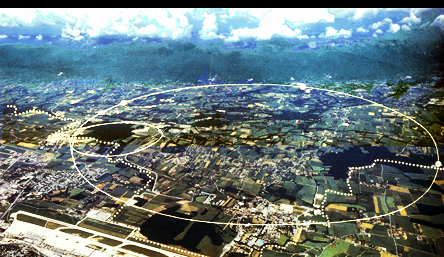

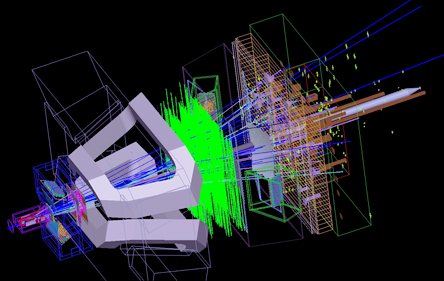
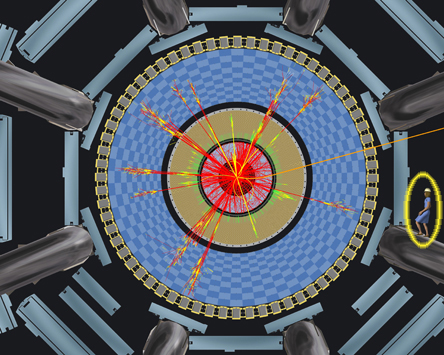
»» Zoomable Tuttocitta Map of Genoa »»
»» New York Times Genoa Travel Guide »»
»» Genoa’s Region — Liguria »»
»» Backgrounder: Eating and Drinking in Genoa »»
»» Planetware Map of Malaga »»
»» New York Times Malaga Travel Guide »»
»» Espana: The official site for tourism in Spain »»
»» Tripadvisor.com Malaga Restaurants »»
»» Casa Natal Picasso »» (Picasso’s birthplace)
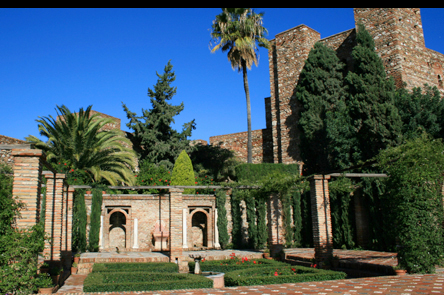
Alcazaba garden, Malaga
»» Casablanca Wikipedia Entry »»
»» Basic downtown Casablanca »»
»» Equally basic downtown but interactive map »»
»» Quick Overview of Moroccan Food »»
»» Morocco: Responsible Tourism »»
»» Hassan II Mosque »» “Built on reclaimed land, almost half of the surface of the mosque lies over the Atlantic water. This was inspired by the verse of the Qur’an that states ‘the throne of God was built on water.’ Part of the floor of this facility is glass so worshippers can kneel directly over the sea.” Although this area is apparently reserved for use by royalty.

The doors of the Hassan II mosque in Casablanca.
»» Casablanca Conference »» (The planning for the Allies’ European strategy in World War II.)
»» America and the Barbary Pirates »» (U.S. Library of Congress — Thomas Jefferson Papers)
»» Zellige: Terra Cotta Tilework »»
»» U.S. Morocco Ties »» (Morocco was the first nation to recognize the United States, in 1787.)
»» Espana: The official site for tourism in Spain »»
»» Official tourism site of Cadiz »» (Excellent background information and detail about life in the Province of Cadiz)
Among the distinctive cuisine of Seville is the light and refreshing “gazpacho” and the richly flavoured “cocido andaluz”. Also worth sampling is “menudo”, cooked with pork, shellfish, and Andalucian asparagus.
»» Spanish Restaurants in Cadiz »»
»» Cadiz architecture »» (covering Moorish, Gothic, Renaissance, and Baroque sites)
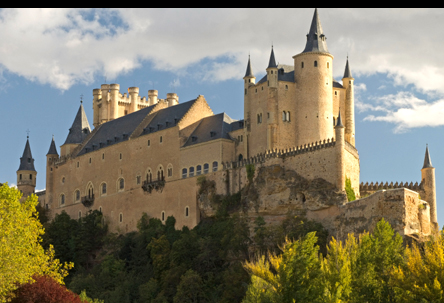
The Alcazar of Segovia as viewed from the forest below.
»» Traditional Portuguese Food »»
»» Lisbon Restaurant Listings: New York Times »»
»» Google map of Baixa/Downtown Lisbon »» (annotated by GoLisbon.com)
»» Map of Belém »» (site of the Belém Tower, Discoveries Monument, and many museums)
»» Uptown Lisbon »» (home of the Gulbenkian and other museums)
»» Go Lisbon »» (Focused information on sites of interest, Portugues culture, maps, dining, Portugal’s celebrated fado music, and much more.)
»» The Lisboa Card »» (Discounted or free admission to notable tourist sites and museums)
»» History of Portugal »» (from the Portuguese Association of History Professsors)
»» History of Portugal »» (Wikipedia)
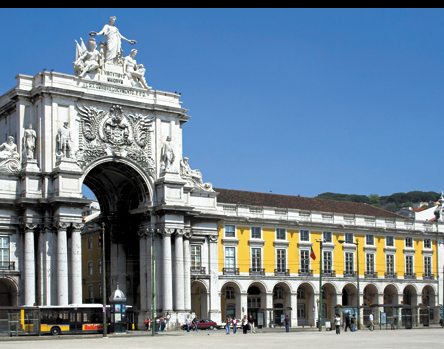
Augusta Street Arch, Lisbon
»» Top 10s of Lisbon »» (Sights, experiences, must-dos, icons, day trips, and architectural curiosities)
The Belém area: home to the »» Jerónimos Monastery and Belém Tower »» (a UNESCO World Heritage Site).
»» The Gulbenkian Museum »» (One of the world’s great museums and one of Europe’s unsung treasures) (also and also)
»» The Azulejo Museum »» (showcasing Portugal’s famed painted tiles) (“Despite its somewhat out-of-the-way location—best reached by taxi—this delightful museum is well worth a visit, presenting five centuries of decorative ceramic tiles or azulejos, tracing the history and production of the art form.”)
»» Valencia City Guide’s Maps »» (Downloadable maps of the city, Old Town, the districts of the city, and a bus map.)
»» Angloinfo’s Google Map of Valencia »»
»» Espana: The official site for tourism in Spain »»
»» Valencia City Guide’s top ten tourist attractions »» (An excellent and succinct summary, covering sites from the UNESCO World Heritage site “Lonja de Seda” to El Miguelete, to the San Pio Museum with its collection of paintings by El Greco, Velazquez, Goya, and others.)
»» Institute Valencian Institute of Modern Art (IVAM) »»
»» San Pío V Museum of Fine Arts »» (Museo de Bellas Artes de Valencia, San Pio V)
»» The González Martí National Ceramics and Sumptuary Arts Museum »» (Museo Nacional de Ceramica y Artes Suntuarias “Gonzalez Marti” — This showcase of Valencian decorative arts is located in the Palace of Marqués de Dos Aguas.)

Fourteenth century Torres De Quart. Notice the canon ball holes left by Napolean.
»» Valencia Cuisine Backgrounder »» (think paella)
»» Valencia Restaurant Listings »» (New York Times)
»» Park Guell »» (home of many Gaudi works)
»» Official City of Barcelona Site »» (interactive map)
»» Official City of Barcelona Site »» (Click on “Gastronomic Route” at bottom of page for Tapas & more)
»» Barcelona.com’s Top 10 Restaurants »»
»» Best Restaurants in Barcelona, by Price »»
»» Gaudi and Modernism »» (Click on the orange box under “places of interest” at the bottom of the page)
»» Gothic Quarter »» (Click on the bright pink box under “places of interest” at the bottom of the page)
»» Palau de la Música Catalana »» (a sampling of Barcelona’s UNESCO World Heritage Architecture)
»» Park Guell »» (home of many Gaudi works)
»» Sagrada Familia »» (Gaudi’s work)

Sagrada Familia by Antoni Gaudi
»» Espana »» (The official site for tourism in Spain)
»» Barcelona Turisme »» (the official site for tourism in Barcelona)
FIND BOOKS (on right)
ABOUT OUR PORTS OF CALL:
The New Spaniards, by John Hooper is a lucid, all-embracing account of Spain’s transformation—political, social, and cultural—within the context of its tortured past (Penguin, $16).
Gaudí, by Gijs Van Hensbergen, is an exemplary biography of Spain’s most singular architect—and an invaluable and well-illustrated look at an astonishing period in the cultural history of Catalonia (HarperCollins, $20).
The Michelin Green Guide to Spain is the most portable general reference and is especially sound on architectural history, with wonderful graphics ($22).
Michelin the Green Guide Italy — Our goal is to provide travelers with practical, accurate and cultural destination information to a city, region or country with emphasis on:
Food Wine The Italian Riviera & Genoa (The Terroir Guides) — Most food guides for Italy suffer from the “too-much, too-little” syndrome. The territory is vast, yet for each city and village they rarely provide enough information. This guide focuses on a manageable territory—Liguria—and covers it in depth with an emphasis on understanding the local culture through its food. This is not an encyclopedic volume but a renowned food writer’s highly selective guide to Liguria’s authentic small eateries, culinary traditions, wine, wineries, food artisans, and gourmet shops. (The “big” restaurants are covered in a short and amusing sidebar that lists the places that everyone knows and can read about in any guide or on the Internet: a tip of the hat to the great toques, but many other suggestions are given so the reader can dine elsewhere. In Italy, the restaurants Michelin rewards with multiple stars have little to do with regional or local food.) Recommendations center on “where the locals eat.” There is a glossary of food items and unusual specialties, as well as a typical Ligurian menu, detailed indexes, many sidebars, and a map.
Genoa: History and Art in an Old Seaport — The book has chapters about history, landmarks, itineraries, then museums, churches, villas, palaces, cemetery,
port, excursions. It is very enterprising in use of fascinating details from artworks to illustrate history and famous Genovese people.
Seville & Andalusia (Eyewitness Travel Guides) — Highlights include: Seville, Huelva, Sevilla, Cordoba, Jaen, Cadiz, Malaga, Granada, and Almeria.
Andalucia: A Cultural History — A garden at the foot of Europe and a crossroads between Spain, Africa and the New World, Andalucia has been a cultural customs house on the border of the
Mediterranean and Atlantic civilizations for more than ten thousand years. This book traces its origins from the earliest hominid settlers in the Granada mountains 1.8 million years ago, through successive Phoenician, Greek, Roman and Muslim cultures, and the past five hundred years of modern Castilian rule, up to and including the present day of post-modern novelists in Cordoba and Sevilla, guerrilla urban archaeologists in Torremolinos and Marbella, and underground lo-fi bands in Granada and Malaga.
Lonely Planet: Morocco — Four authors, 136 days of in-country research, 98 detailed maps, and six camel rides. Color arts and crafts chapter with shopping tips and an index of traveler workshops A former Moroccan tour guide heads up our team of expert authors in revealing the true Morocco Content updated daily—visit lonelyplanet.com for up-to-the-minute reviews, updates and traveler insights.
Casablanca — A truly perfect movie, the 1942 Casablanca still wows viewers today, and for good reason. Its unique story of a love triangle set against terribly high stakes in the war against a monster is sophisticated instead of outlandish, intriguing instead of garish. Humphrey Bogart plays the allegedly apolitical club owner in unoccupied French territory that is nevertheless crawling with Nazis; Ingrid Bergman is the lover who mysteriously deserted him in Paris; and Paul Heinreid is her heroic, slightly bewildered husband. Claude Rains, Sydney Greenstreet, Peter Lorre, and Conrad Veidt are among what may be the best supporting cast in the history of Hollywood films. This is certainly among the most spirited and ennobling movies ever made.
Making of Casablanca, The: Bogart, Bergman, and World War II — The Making of Casablanca offers the ultimate insider’s look at the politics and personalities behind the most celebrated movie of all time—Casablanca. Updated and timed for the 60th anniversary (Thanksgiving Day, 1942) of this movie, this critically acclaimed book draws upon years of research, including access to Ingrid Bergman’s personal acting diaries and the vast Warner Brothers archives, as well as interviews with many of those close to the film, including the late Paul Henreid, Lauren Bacall, and scriptwriters Howard Koch and Julius Epstein. Richly detailed and full of surprises, The Making of Casablanca debunks many cherished myths about the casting, script, story, and stars, to reveal the realities of the highly pressured Hollywood studio system during World War II.
Morocco: From Empire to Independence — From the Strait of Gibralter to the snowy peaks of the Atlas Mountains and the windswept Sahara, this book captures a history as diverse and dramatic as Morocco’s legendary landscapes and cities. Beginning with Morocco’s incorporation into the Roman Empire, this is the tale of powerful empires, fearsome pirates, a bloody struggle against colonialism and an equally hard-won independence. It charts Morocco’s uneasy passage to the 21st century, and reflects on the nation of citizens that is finally emerging from this diverse population of Arabs, Berbers and Africans. The story of a country at the crossroads of two continents, this history of Morocco provides a glimpse of an imperial world of which only the architectural treasures remain, and a profound insight into the economic, political and cultural influences that will shape the country’s future.
Knopf Guide: Morocco — Standing at the gateway of the Mediterranean, Morocco can easily lay claim to being one of the most beautiful places in the world. Greatly influenced by the Porteguese, French and Spanish, all the while maintaining its own indelible mystique, Morocco is a country of walled cities, snowcapped mountains, royal palaces, spicy cuisine and chaotic, labyrinthine souks. It
is romantic, exotic and at once sophisticated and primitive. Begin your travels across the country—filled with untold treasures and possibilities as magical as its night-blooming jasmine—with a journey to the Portuguese citadel of El Jadida and then move on to the stunning cities of Fez, Tangier and Marrakesh. Become knowledgeable in the local culinary specialties such as ras el hanout or “head of the house”, a blend of cloves, roses, and cinnamon mixed by well-practiced grocers. Filled with information on Morocco’s rich artistic heritage from the many foreign artists who were inspired by its landscape and people (Henri Matisse, Eugene Delacroix and Paul Bowles among them) to the indigenous production of rugs, jewelry, and zellige (elaborate tile patterns) that has gone on for centuries.
Lonely Planet: Spain — Here is an imagination-fueling guide on how to experience the best Spain has to offer. With lively features on Spanish history; coverage of Spanish Catalan, Basque, and Galician languages; more than 145 maps, including metro maps for Madrid and Barcelona; details on outdoor activities, including national parks; chapters on Madrid and Barcelona; plus hundreds of options for food and accommodations no matter what your budget, you’ll be hard-pressed to limit your stay.
The Romans in Spain (A History of Spain) — This book traces the complex process by
which an area, seen initially as a war-zone, was gradually transformed by the actions of the Romans and the reactions of the indigenous inhabitants into an integral part of the Roman world.
Lisbon (Eyewitness Travel Guides) — Includes sections on: Alfama, Baixa, Bairro Alto, Estrela, Belém, the Lisbon Coast, and several other sites further afield.
The Last Day: Wrath, Ruin, and Reason in the Great Lisbon Earthquake of 1755 — The Lisbon earthquake of 1755 exerted a great cultural, religious, and political impact, argues Shrady in this revelatory volume. On November 1 (both a Sunday and All Saints’ Day) at 9:30am, a titanic earthquake shattered the quiet, turning the pious city’s packed houses of worship into crypts as their walls collapsed. Five days of firestorms consumed the buildings left standing and a tsunami drowned the benighted survivors who escaped toward the ocean. As Shrady deftly details, Europe was stunned by the merciless destruction of one of the continent’s most opulent cities. Leading intellectual and philosophical figures—Voltaire, Rousseau, Pope, Goethe and Kant, among others—became fascinated by the question of divine intervention in human affairs. Lisbon, still home to the Inquisition, had been immolated: was this evidence of God’s wrath or of God’s nonexistence? The latter interpretation soon found its way into Voltaire’s cynical, secularist Enlightenment masterpiece, Candide. Within the decade, scholars had created the new discipline of seismology, and governments were taking their first faltering steps toward urban planning and disaster control. Shrady’s account will find the same ready audience that delight not only in tales of catastrophe but in smart, stylishly written history.
The Night in Lisbon by Erich Maria Remarque — With the world slowly sliding into war, it is crucial that enemies of the Reich flee Europe
at once. But so many routes are closed, and so much money is needed. Then one night in Lisbon, as a poor refugee gazes hungrily at the boat enroute to America, a man approaches him with two tickets and a story to tell. It is a harrowing tale of bravery and butchery, daring and death, where the price of love is beyond measure, and the legacy of evil is infinite. And as the young man listens spellbound to the desperate teller, in a matter of hours, the two form a unique and unshakable bond—one that will last all their lives ...
Lonely Planet Best of Valencia — Sizzling on Spain’s Mediterranean coast, Valencia is a heady contrast of old and new. Baroque buildings nestle up to contemporary architectural triumphs, while elaborate religious processions are followed by exuberant street parties. In the heart of the old town or relaxing on the beach, Best of Valencia puts the whole city in your pocket.
Valencia Land of Wine — Joan introduces you to new wineries, styles of wines, old histories, and imbues it all with his expert knowledge culled from a lifetime among the wines of Valencia. The author, Joan C. Martín, is a prize-winning wine writer and winemaker. This collection consists of articles, here translated into English, that originally appeared in Spain’s “El País” newspaper, and is the best introduction available not only to the wines of the Comunidad Valenciana, but also to the people who make them and the landscape in which they are made.
St. Laurence and the Holy Grail — Many scholars are convinced that The Holy Chalice of Valencia is the Holy Grail, celebrated in medieval legneds as it was venerated by monks in the secluded Monastery of San Juan de la Peña, built into a rocky outcropping of the Spanish Pyrenees. The tradition of Aragón has always insisted that the flaming agate cup of the Holy Chalice was sent to Spain by St. Laurence, the glorious Spaniard martyred on a gridiron during the Valerian persecution in Rome in 258 AD. Now there is new evidence: A sixth-century manuscript written in Latin by St. Donato, an Augustinian monk who founded a monastery in the area of Valencia, provides never-before-published details about Laurence, born in Valencia but destined for Italy, where he became treasurer and deacon of the Catholic Church under Pope Sixtus II. It explicitly mentions the details surrounding the transfer of the Holy Cup of the Last Supper to Spain. Janice Bennett acquaints the reader with the enthralling story of the Holy Chalice, the renowned relic that embarked from the Last Supper on an amazing pilgrimage that providentially ended in the Cathedral of Valencia, a miraculous odyssey that has been characterized by dnager, greed, martyrdom, and fire from the very beginning.
Barcelona and Modernity: Picasso, Gaudi, Miro, Dalí — During the years after the September Revolution of 1868, Barcelona experienced tremendous industrial growth and emerged as the most politically and culturally progressive city in Spain. Barcelona and Modernity examines this remarkable seventy-one-year period, when Barcelona also reigned as one of the most dynamic centers of modernist art and architecture in Europe. Focusing on the Catalan Renaixença, Modernisme, Noucentisme, avant-garde movements of the early 20th century, and artistic reactions to the Spanish Civil War, essays by an extraordinary international team of scholars offer new insights into the work of such Catalan artists as Antoni Gaudí, Pablo Picasso, Joan Miró, and Salvador Dalí, among others, by setting them in context with the art of their teachers, colleagues, and rivals. With approximately 350 works in a variety of media—painting, sculpture, photography, furniture, decorative arts, and architectural design—this intriguing book also explores how Catalan artists derived inspiration from local traditions while contributing their own innovations to international modernism. Broader in scope than any previous treatment of the subject, this book is sure to alter popular perceptions of Catalonia and become a fundamental text for years to come.
Tapas: The Little Dishes of Spain — Tapas are to Spain as pasta is to Italy — a fundamental culinary form of unending variety. And with Tapas, Casas (The Foods and Wines of Spain) continues to do for Spanish cooking what Marcella Hazan has done for Italian. Tapas are appetizers of every descriptionfinger food and salads, marinades and pates, tarts and toasts, beans, sauced dishes, even some soups. The author provides recipes for a tempting selection of dishes that conveys Spain’s love for all types of seafood and sausage, potatoes and peppers, saffron, garlic, paprika, and green sauce. Since tapas are, by definition, little dishes, quite a few recipes require a disproportionate amount of work per ounce, and one should get used to lists calling for a cup of strong chicken broth or two tablespoons of peas. Suggestions for tapas menus are listed, as are leading tapas bars in Spain.
The Cuisines of Spain: Exploring Regional Home Cooking — Born and raised in Spain’s Basque Country, Teresa Barrenechea (The Basque Table), has been very purposeful with her title, choosing the plural, cuisines, to speak of Spain in her most recent book, The Cuisines of Spain. There is no one Spanish food, plain and simple. And what the author wants to convey is a sense of place for the many delicious dishes she presents (there are over 250 recipes). The author’s first two chapters describe in great detail the history and geography of Spain’s regions which she groups by shared climate and natural resources. She calls this “following bean stews rather than political boundaries.” Woven into this tapestry are traces of the Phoenicians, ancient Greeks, Romans, Celts, Visigoths and Vandals (who left behind livestock farming practices), Moorish and Jewish culture, and, of course, the New World impacts of foods returning with Columbus—tomatoes, potatoes, corn, peppers. She gets granular—which pigs, grown where and eating what, contribute to the great hams of Spain.
GENERAL INFORMATION AND DOCUMENT REQUIREMENTS
A Passport (valid through February 16, 2011 or 90 days after your return from this
trip) is required. Non-U.S. citizens residing in the United States will need
valid Alien Registration (green) cards as well. All others must have valid passports
and any required visas when boarding the vessel. All travel documents such as
passports, visas, proof of citizenship, etc., that are required for embarkation,
disembarkation at the ports of call, and re-entry into the United States are
the responsibility of the passenger. American citizens should visit the U.S.
Department of State for information on entry requirements for a specific country.
Please go to the Entry/Exit
Requirements section in the Country Specific Information for the country
you are interested in. You may also contact the U.S. embassy or consulate of
that country for further information.
Non-U.S. citizens are asked to check with their government agencies, embassies or consulates to determine documentary requirements. You may be denied boarding without proper proof of citizenship. All travel documents such as passports, visas, proof of citizenship, etc., that are required for embarkation, disembarkation at the ports of call, and re-entry into one’s country of residence are the responsibility of the passenger.
The National Passport Information Center (NPIC) is the U.S. Department of State’s single, centralized public contact center for U.S. passport information. Telephone: 1-877-4-USA-PPT (1-877-487-2778); TDD/TTY: 1-888-874-7793. Passport information is available 24 hours, 7 days a week. You may speak with a representative Monday–Friday, 8am–10pm, Eastern Time, excluding federal holidays.
U.S. EMBASSIES & CONSULATES ALONG OUR ITINERARY
The U.S. Consular Agency in Genoa offers limited citizen services. It is located at Via Dante 2 - 16121 GENOVA. Phone: 011-39-010-584-492. Fax: 011-39-010-5533-033 U.S. Citizen Services, Consular Section hours are Monday–Thursday, 11am–3pm. e-mail.
The U.S. Consulate General in Milan offers a full range of services for U.S. citizens in the regions of Valle D’Aosta, Piemonte, Lombardia, Veneto, Trentino-Alto Adige, Friuli-Venezia Giulia, Liguria, and Emilia-Romagna (Provinces of Piacenza and Parma only). It is located at Via Principe Amedeo, 2/10 - 20121 MILANO. Telephone: 011-39-02-290351. Email: uscitizensmilan@state.gov. Website: U.S. Citizen Services. Consular Section hours are Monday–Friday, 8:30am–12 Noon.
The Malaga U.S. Consular Offices offer limited citizen services. Because each province may have their own local holiday, it is strongly recommended that individuals contact the agency by phone before appearing. The U.S. Consulate in Malaga is at Avenida Juan Gómez “Juanito” 8, Edificio Lucía 1º-C, 29640 Fuengirola (Málaga), Spain. Consular Section hours are Monday–Friday, 10am–2pm. Phone: 95247-4891.
U.S. Consular Agency Seville offers limited citizen services. It is located at Plaza Nueva 8-8 duplicado, 2ª planta, E2, Nº 4, 41001 Sevilla. Phone: 954-218-751. Consular Section hours are Monday–Friday, 11am–1pm BY APPOINTMENT ONLY. Please call to schedule an appointment.
U.S. Consular Agency Valencia offers limited citizen services. It is located at Dr. Romagosa, 1, 2, J 46002, Valencia, Spain. Consular Section hours are 10am or 12 Noon to 2pm. Phone: 96351-6973.
The U.S. Consulate General in Barcelona offers a full range of services for U.S. citizens. It is located at Paseo Reina Elisenda de Montcada, 23 08034 Barcelona, España. Phone: 011-34-93 280 22 27. Fax: 011-34-93 280 61 75. Consular Section hours open to the public Monday–Friday, 9am–1pm, except for local and U.S. holidays. For emergency assistance after hours, American citizens may call 91-587-2200 and ask to speak to the duty officer. No documentary or passport services are available evenings, weekends, or holidays. The Consulate is located in the Sarrià/Sant Gervasi district of Barcelona.
U.S. Consulate General in Casablanca offers a full range of services for U.S. citizens. It is located at 8 Boulevard Moulay Youssef, Casablanca. The Consular Section’s American Citizens Services hotline is 0522-26-71-51. For any ACS related question, please contact the Consular Section via email or visit the Consulate website for information on all consular services and other assistance offered in Casablanca. The U.S. Consulate General is open to U.S. citizens for routine consular services from 8:30am–9:30am and from 1:30pm–3:00pm every Monday–Thursday, excluding U.S. and Moroccan holidays. Casablanca - Emergencies Only, after-hours phone: 0661-17-23-67 or 0522-26-45-50.
— U.S. Embassy in Rabat offers a full range of services for U.S. citizens. It is located at 2 Avenue Mohamed El Fassi, Rabat, Morocco. Phone: 212-37-76-22-65. After-hours phone: 212-37-76-96-39. The Embassy’s working hours are Monday–Friday, 8am–5pm. Website.
U.S. Embassy Lisbon in Portugal offers a full range of services for U.S. citizens. It is located at Av. das Forças Armadas, Sete-Rios, 1600-081 Lisbon, Portugal Public phone hours are from 2pm–4pm, Monday–Friday. Phone: 21-770-2122. You may make an appointment for services from 8am–10am, Monday–Friday, and from 1:30pm–3:30-pm, Mondays and Wednesdays. The Embassy has walk-in hours from 10am–11:30am, daily. After-hours or on weekends/holidays, you may contact the Embassy’s Duty Officer by calling the Main Switchboard at: 21-727-3300, press “O” to speak directly to an Embassy official. Email.
ELECTRICITY
The electrical current in Italy and Morocco is AC, 127/220 volts or 220/380 volts,
50 cycles. The electrical current in Portugal and Spain is AC, 220/380 volts,
50 cycles. Wall outlets take plugs with two rounded prongs. If you plan to use
U.S. electrical appliances you will need to bring a converter and an adapter
(however, many appliances and laptops can take 220 volts; if yours can, you only
need the two-prong adapter).
CDC TRAVELERS’ HEALTH
WEBSITE
Travelers can check the latest health information with the U.S. Centers for Disease
Control and Prevention in Atlanta, Georgia. A hotline at 800-CDC-INFO (800-232-4636)
and a website give
the most recent health advisories, immunization recommendations or requirements,
and advice on food and drinking water safety for regions and countries. The CDC
publication Health
Information for International Travel is worth looking over.
U.S.
CENTERS FOR DISEASE CONTROL AND PREVENTION (CDC)
Health information, with Recommendations or Requirements for Vaccine-Preventable
Diseases for travelers to Italy, Morocco, Portugal,
and Spain.
U.S.
CUSTOMS AND BORDER PROTECTION
For information on airport and port-related declaration of goods, immigration issues,
and more.
U.S.
DEPARTMENT OF STATE EMERGENCY ASSISTANCE TO AMERICAN CITIZENS ABROAD
U.S. Department of State Emergency Assistance to American Citizens Abroad: American
Citizens Services and Crisis Management (ACS)
RELEVANT FOREIGN EMBASSIES
For further information concerning visas and entry requirements for Italy, travelers may contact the Embassy of Italy at 3000 Whitehaven Street NW, Washington, DC 20008, via telephone at 1-202-612-4400 or online, or Italian Consulates General in Boston, Chicago, Detroit, Houston, Los Angeles, Miami, Newark, New Orleans, New York, Philadelphia, or San Francisco, accessible through the Italian Embassy website.
For further information concerning visas and entry requirements for Spain, travelers should contact the Embassy of Spain at 2375 Pennsylvania Avenue NW, Washington, DC 20037, by telephone 1-202- 452-0100 or online or the nearest Spanish Consulate in Boston, Chicago, Houston, Los Angeles, Miami, New Orleans, New York, San Francisco, or San Juan. Additional information may be obtained from the Tourist Office of Spain in New York at 1-212-265-8822.
For further information concerning visas and entry requirements for Portugal, travelers should contact the Embassy of Portugal at 2012 Massachusetts Avenue NW, Washington, DC 20036, by telephone at 1-202-350-5400 or online. You can also contact Portuguese Consulates in Boston, MA; New Bedford, MA; Providence, RI; New York, NY; Newark, NJ; San Francisco, CA; or Los Angeles, CA.
For further information concerning visas and entry requirements for Portugal, travelers should contact the Embassy of Morocco 1601 21st Street NW, Washington, DC 20009, by telephone 1-202-462-7979 and online. You can also contact the Moroccan Consulate General in New York at 10 E. 40th Street, New York, NY 10016, telephone 1-212-758-2625.
U.S. STATE DEPARTMENT’S COUNTRY-SPECIFIC INFORMATION FOR U.S. CITIZENS
Important details on entry and exit requirements for U.S. citizens, information on safety and security, crime, MEDICAL FACILITIES AND HEALTH INFORMATION, and more are located here. ENTRY/EXIT Document REQUIREMENTS for Italy for U.S. Citizens. Italy is a party to the Schengen agreement. As such, U.S. citizens may enter Italy for up to 90 days for tourist or business purposes without a visa. The passport should be valid for at least three months beyond the period of stay. Non-U.S. citizens are asked to check with government agencies, embassies or consulates to determine documentary requirements related to the Schengen agreement. You may be denied boarding without proper proof of citizenship. For further information concerning visas and entry requirements for Italy, travelers may contact the Embassy of Italy at 3000 Whitehaven Street NW, Washington, DC 20008, via telephone at 1-202-612-4400 or online, or Italian Consulates General in Boston, Chicago, Detroit, Houston, Los Angeles, Miami, Newark, New Orleans, New York, Philadelphia, or San Francisco accessible through the Italian Embassy website.
Important details on entry and exit requirements for U.S. citizens, information on safety and security, crime, MEDICAL FACILITIES AND HEALTH INFORMATION, and more are located here. Spain is a party to the Schengen agreement. As such, U.S. citizens may enter Spain for up to 90 days for tourist or business purposes without a visa. The passport should be valid for at least three months beyond the period of stay. ENTRY/EXIT Document REQUIREMENTS for Spain for U.S. Citizens. Spain is a party to the Schengen agreement. As such, U.S. citizens may enter Spain for up to 90 days for tourist or business purposes without a visa. The passport should be valid for at least three months beyond the period of stay. Non-U.S. citizens are asked to check with government agencies, embassies or consulates to determine documentary requirements related to the Schengen agreement. You may be denied boarding without proper proof of citizenship. For further information concerning entry requirements for Spain, travelers should contact the Embassy of Spain at 2375 Pennsylvania Avenue NW, Washington, DC 20037, telephone 1-202-452-0100, or the nearest Spanish Consulate in Boston, Chicago, Houston, Los Angeles, Miami, New Orleans, New York, San Francisco, or San Juan. Additional information may be obtained from the Tourist Office of Spain in New York at 1-212-265-8822.
Important details on entry and exit requirements for U.S. citizens, information on safety and security, crime, MEDICAL FACILITIES AND HEALTH INFORMATION, and more are located here. Portugal is a party to the Schengen agreement. As such, U.S. citizens may enter Portugal for up to 90 days for tourist or business purposes without a visa. The passport should be valid for at least three months beyond the period of stay. ENTRY/EXIT Document REQUIREMENTS for Portugal for U.S. Citizens. Portugal is a party to the Schengen agreement. As such, U.S. citizens may enter Portugal for up to 90 days for tourist or business purposes without a visa. The passport should be valid for at least three months beyond the period of stay. Non-U.S. citizens are asked to check with government agencies, embassies or consulates to determine documentary requirements related to the Schengen agreement. You may be denied boarding without proper proof of citizenship. For further information concerning entry requirements for Portugal, travelers should contact the Embassy of Portugal at 2012 Massachusetts Avenue NW, Washington, DC 20036, phone 1-202-350-5400 or the Portuguese Consulates in Boston, MA; New Bedford, MA; Providence, RI; New York, NY; Newark, NJ; San Francisco, CA; or Los Angeles, CA. Visit the Government of Portugal’s website for the most current visa information.
Important details on entry and exit requirements for U.S. citizens, information on safety and security, crime, MEDICAL FACILITIES AND HEALTH INFORMATION, and more are located here. Travelers to Morocco must have a valid passport. Visas are not required for American tourists traveling to Morocco for fewer than 90 days. U.S. citizens are encouraged to carry a copy of their U.S. passports with them at all times, so that, if questioned by local officials, proof of identity and U.S. citizenship is readily available. For further information concerning exit/entry requirements for Morocco, please contact the Embassy of Morocco at 1601 21st Street NW, Washington, DC 20009, phone 1-202-462-7979 to 82 or the Moroccan Consulate General in New York at 10 E. 40th Street, New York, NY 10016, phone 1-212-758-2625.
CALLING INTERNATIONALLY
U.S. DEPARTMENT OF STATE BACKGROUNDER ON:
264 S. Meridith Ave., Pasadena, CA 91106 • 650-787-5665 • Copyright 2009 © InSight Cruises